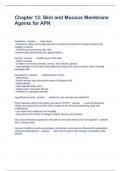Mucous mem - Study guides, Class notes & Summaries
Looking for the best study guides, study notes and summaries about Mucous mem? On this page you'll find 90 study documents about Mucous mem.
All 90 results
Sort by
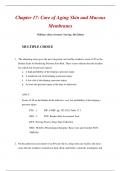
-
Chapter 17: Care of Aging Skin and Mucous Membranes
- Exam (elaborations) • 16 pages • 2024
-
Available in package deal
-
- $5.65
- + learn more
MULTIPLE CHOICE 1. The admitting nurse gives the new long-term care facility resident a score of 20 on the Braden Scale for Predicting Pressure Sore Risk. These scores indicate that the resident has which risk for pressure injury? a. A high probability of developing a pressure injury b. A moderate risk of developing a pressure injury c. A low risk of developing a pressure injury d. At least one pressure injury at the time of admission ANS: C Scores of 20 on the Braden Scale ind...
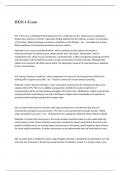
-
HESI 4 Exam/If the nurse is initiating IV fluid replacement for a child who has dry, sticky mucous membranes, flushed skin, and fever of 103.6 F. Laboratory finding indicate that the child has a sodium concentration of 156 mEq/L. What physiologic mechanis
- Exam (elaborations) • 25 pages • 2024
- Available in package deal
-
- $11.99
- + learn more
HESI 4 Exam/If the nurse is initiating IV fluid replacement for a child who has dry, sticky mucous membranes, flushed skin, and fever of 103.6 F. Laboratory finding indicate that the child has a sodium concentration of 156 mEq/L. What physiologic mechanis
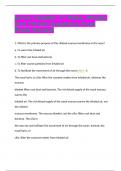
-
ter 17 Nose, Mouth, and Throat Questions Final Exam Review 1. What is the primary purpose of the ciliated mucous membrane in the nose? a. To warm the inhaled air b. To filter out dust and bacteria c. To filter coarse particles from inhaled air d. To faci
- Exam (elaborations) • 32 pages • 2024
-
- $10.99
- + learn more
ter 17 Nose, Mouth, and Throat Questions Final Exam Review 1. What is the primary purpose of the ciliated mucous membrane in the nose? a. To warm the inhaled air b. To filter out dust and bacteria c. To filter coarse particles from inhaled air d. To facilitate the movement of air through the naresANS>>: C The nasal hairs, or cilia, filter the coarsest matter from inhaled air, whereas the mucous blanket filters out dust and bacteria. The rich blood supply of the nasal mucosa warms ...
Chapter 13 Skin and Mucous Membrane Agents for APN
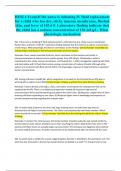
-
HESI 4 Exam/If the nurse is initiating IV fluid replacement for a child who has dry, sticky mucous membranes, flushed skin, and fever of 103.6 F. Laboratory finding indicate that the child has a sodium concentration of 156 mEq/L. What physiologic mech
- Exam (elaborations) • 23 pages • 2023
-
- $10.99
- + learn more
HESI 4 Exam/If the nurse is initiating IV fluid replacement for a child who has dry, sticky mucous membranes, flushed skin, and fever of 103.6 F. Laboratory finding indicate that the child has a sodium concentration of 156 mEq/L. What physiologic mechanism 301. If the nurse is initiating IV fluid replacement for a child who has dry, sticky mucous membranes, flushed skin, and fever of 103.6 F. Laboratory finding indicate that the child has a sodium concentration of 156 mEq/L. What ph...

-
PHARMACOLOGY FOR NURSES (CHAPTER 1-11 TERMS) QUESTIONS AND ANSWERS LATEST UPDATE A+ GRADED Routes of drug administration enteral, parenteral, percutaneous percutaneous administration application of medications to the skin or mucous membranes for absor
- Exam (elaborations) • 16 pages • 2024
-
- $8.49
- + learn more
PHARMACOLOGY FOR NURSES (CHAPTER 1-11 TERMS) QUESTIONS AND ANSWERS LATEST UPDATE A+ GRADED Routes of drug administration enteral, parenteral, percutaneous percutaneous administration application of medications to the skin or mucous membranes for absorption what can be influence topical medications drug concentration, how long the medication has skin contact, size of affected area, skin thickness, hydration of tissues, degree of skin disruption Methods of percutaneous administration ...
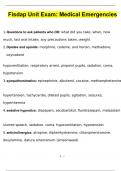
-
Fisdap Unit Exam Medical Emergencies Questions and Verified Answers (2024 / 2025)/ A+ GRADE
- Exam (elaborations) • 80 pages • 2024
- Available in package deal
-
- $12.49
- + learn more
Fisdap Unit Exam Medical Emergencies Questions and Verified Answers (2024 / 2025)/ A+ GRADE.1. Questions to ask patients who OD: what did you take, when, how much, last oral intake, any precautions taken, weight 2. Opiates and opioids: morphine, codeine, and heroin, methadone, oxycodone hypoventilation, respiratory arrest, pinpoint pupils, sedation, coma, hypotension 3. sympathomimetics: epinephrine, albuterol, cocaine, methamphetamine hypertension, tachycardia, dilated pupils, agitation, ...
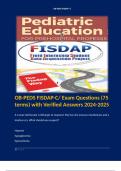
-
OB-PEDS FISDAP-C/ Exam Questions (75 terms) with Verified Answers 2024-2025. Terms like: A 2-year-old female is lethargic to respond. She has dry mucous membranes and a tearless cry. What should you suspect? Hypoxia hypoglycemia hypovolemia hypothermia D
- Exam (elaborations) • 25 pages • 2024
- Available in package deal
-
- $8.59
- + learn more
OB-PEDS FISDAP-C/ Exam Questions (75 terms) with Verified Answers . Terms like: A 2-year-old female is lethargic to respond. She has dry mucous membranes and a tearless cry. What should you suspect? Hypoxia hypoglycemia hypovolemia hypothermia Dehydration - Answer: hypovolemia
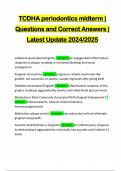
-
TCDHA periodontics midterm | Questions and Correct Answers | Latest Update 2024/2025
- Exam (elaborations) • 11 pages • 2024
-
- $11.49
- + learn more
TCDHA periodontics midterm | Questions and Correct Answers | Latest Update 2024/2025 Leukemia-Associated Gingivitis - Answer -An exaggerated inflammatory response to plaque resulting in increased bleeding and tissue enlargement Pyogenic Granuloma - Answer -pregnancy related mushroom-like growth, not cancerous or painful. usually regresses after giving birth Diabetes-Associated Gingivitis - Answer -inflammatory response of the gingiva to plaque aggravated by poorly controlled blood gluco...
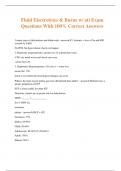
-
Fluid Electrolytes & Burns w/ ati Exam Questions With 100% Correct Answers
- Exam (elaborations) • 19 pages • 2024
- Available in package deal
-
- $12.49
- + learn more
Fluid Electrolytes & Burns w/ ati Exam Questions With 100% Correct Answers 3 major types of dehydration and define each - answer1. Isotonic: = loss of Na and H20 (caused by V&D) Na WNL but hypovolemic shock can happen 2. Hypotonic (hyponatremic): greater loss of sodium than water. -CM's are much worse and shock can occur -serum Na<130 3. Hypertonic (Hypernatremic): NA loss is < water loss. serum Na> 150 shock is less likely but neurological changes can occur What is the main...

Did you know that on average a seller on Stuvia earns $82 per month selling study resources? Hmm, hint, hint. Discover all about earning on Stuvia

